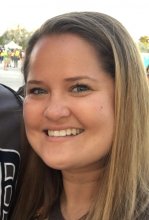Educator Spotlight: Adventures in Blending with Maddi Spado

In this Educator Spotlight, Maddi Spado shares her experiences from JBlend Miami, explains how she uses the station rotation model, and talks about the benefits of blended learning for her students.

Maddi Spado is a fourth grade teacher at The Gordon School of Beth David Congregation. She wears many hats, including National Elementary Honor Society advisor, blended learning coach, and Sunshine Committee participant brightening the day for teachers and staff. She is part of the JBlend Miami program through CAJE Miami and has become a leader in her school in the blended learning movement, bringing a variety of programs and techniques into her classroom. Maddi graduated with a Bachelor's Degree in English from The George Washington University in Washington, D.C. She received her Florida Teacher’s Certifications in English grades 6-12 and in Elementary Education and is working toward a Master’s Degree in English Education.
What have been the highlights of participating in JBlend Miami?
The collaboration with the other schools is the biggest highlight for me. That collaboration includes: talking to the teachers from other schools, hearing about what they’re doing, bouncing ideas off each other, working through problem points, and brainstorming solutions. It’s great hearing that the challenges we’re going through as a small school are the same challenges the larger schools are facing. Blended learning is new for everyone in JBlend, so being able to learn it all together makes a difference. You might have an idea of what something is, and then someone sees it differently, and you can share with each other, and modify your original idea to be something greater. I also like the regularity of the meetings; since I have to find a substitute teacher for my class each time, it’s actually good practice for relinquishing control of my classroom.
What are some ways JBlend has influenced your classroom and teaching?
Going to JBlend I got to hear what teachers thought about using a variety of classroom tools. They’d say, “This program is really cool for this subject” and “this one’s really cool if I want my students to do this.” I heard about Kahoot! through tutoring students in older grades at different schools, and when a teacher brought it up at a JBlend meeting, I knew I had to try it in my own class. Now my students love it and want to do it every day. Hearing from other teachers about tools makes me less intimidated to try new things.
Experimenting with the space in my classroom is also something I got out of JBlend. I grew up in a traditional classroom setting with the teacher at the front, but I’m seeing how different setups can work better for different students. During the JBlend school visits in April last year, I saw how teachers were shifting the classroom space and revolutionizing learning. It’s easier to understand change when you can actually see the difference in practice, so it’s been one of the easiest things for me to test out. For kids, sitting on a pillow and reading is more natural than sitting at a desk to read, so why shouldn’t they be doing it comfortably? Some kids like reading no matter how they’re sitting. For the ones who don’t, the appeal of sitting on the floor on a pillow adds to the enjoyment of reading. Sometimes we’ll push the desks to the outside of the classroom and put pillows in the middle. It’s a position conducive to enhancing their learning. Sitting at a desk all day is torturous for anybody. I probably change up my classroom set up every couple weeks. I change who sits next to whom and where they sit. Some students even say they like sitting by themselves and that it helps them concentrate better. I’ve tried having students sit in groups of three or four, but that works for some and not for others. Sitting in pairs, either across or next to each other has worked really well. The set up just depends on what lesson or activity we’re doing. I haven’t found the perfect way to set up the room, but I like experimenting with the idea of everything moving around all the time. It’s hard to train kids to get away from the ownership of a desk. Next year I’m only going to keep textbooks inside the desks and the students will put all their personal items in cubbies. Then it won’t be one particular student assigned to one desk.
Another takeaway from JBlend was the “3B4me” strategy, which another teacher told us about and I brought into my classroom. The three Bs are “Brain, Book, and Buddy”; each student knows they need to try and find the answer first on their own, then by looking up the answer, and then by asking a buddy before they come to me with questions. As a result, they are doing much more collaborative work together. They rely on their buddies as their first resource for help instead of me. They don’t need me as much now that they can rely on their peers. That strategy for encouraging independence has spread; four other teachers at Gordon, from second through fifth grade, are using it and the students expect that now.
What are some ways blended learning has changed your classroom?
One of the most successful aspects of using blended learning is giving the students a variety of options. The blended classroom is the best thing when we’re working on a long term project. I set deadlines way in advance and then break down everything on a week by week basis. The students work on each part of the project at their own pace, so I might have six students doing i-Ready, three working on their projects, and then another three working on grammar. They all take pride in what they’re doing and know what needs to get done. They also like the fact that I know what they’re each doing, even though everyone is doing something different. When working on those long term projects, and also needing to get curriculum work done, blended learning helps me give them a way to take ownership and work at their own pace. That pride and ownership of their work come from their understanding that everyone works at their own pace, and it’s not a bad thing, or a sign of a lack of intelligence, everyone just works differently.
How does educational technology support blended learning in your classroom?
Our school has a subscription to i-Ready for reading and math. Over the summer, I went to a brief training to learn to use some of the newer i-Ready features, and now I’ve been experimenting with the program. You can assign specific lessons to specific students, so it’s great if I want to teach or supplement a lesson. If a student doesn’t understand a topic, I can intervene and reassign it. The program has made a big difference in terms of personalization. When we do stations, students can sit around large tables, on the floor, or at their desks. There’s an independent station at which they use i-Ready for self-paced learning, another station is teacher-led, and the third station is collaborative. It’s still new for them to have the teacher act only as support instead of leading everything. I try to track all the data from i-Ready, which helps me to differentiate the learning. I pay close attention to those students who are at a lower level and I try to assign them specific lessons to make sure they’re filling in those gaps. I’ve also kept track of how much time students spend on i-Ready each week. I noticed that the students who use i-Ready more regularly have improved, so I want the students at a lower level to dedicate more time to it because I’ve seen the benefits.
The biggest advantage [of blended learning] is being able to respond to a variety of learners in the classroom. It has also made it easier to give students one-on-one time with me so that they are getting the support they need.
What are the advantages of using educational technology and blended learning?
It’s sometimes hard to keep this particular group on task, but they do get very excited and like trying different things. They always want to know “why” and have a great sense of curiosity. One of the biggest advantages of having technology in the classroom is the flexibility of both the learning and teaching. If the students aren’t comfortable with something, they speak up about it, and I might make the lesson easier or more challenging for that student and not feel like I’m pushing the entire class. The opportunity for independent learning is also great. The biggest advantage is being able to respond to a variety of learners in the classroom. It has also made it easier to give students one-on-one time with me so that they are getting the support they need. I’ve seen the benefit of being able to use my time better, and overall it’s been working out really nicely.
What’s a highlight from your time teaching with technology and blended learning?
I have two that come to mind. The first one was getting buy-in from the parents. I’ve heard from other schools that parents will say “Why are we changing things? Everything is fine.” At the same time, they’ll also say they want their child to have more challenging work or more support in a particular subject. Schools have to communicate with parents that in a blended classroom you individualize the learning, so if a student needs harder vocabulary words, she can have them, and if another student needs easier words, she can have them, too. It’s important to get the message to parents that for every child to be comfortable learning we’re switching up what happens in the classroom. One of the moms who was hesitant about the amount of screen time the kids would have in a blended classroom, actually donated pillows to our class so that everyone has a pillow to sit on when doing work on the floor. It was a huge thing to have buy-in from a parent, and especially that mom, in particular, She liked what we were doing so much that she bought us pillows.
The second highlight is from when I first introduced blended learning with a station rotation in my classroom. From my perspective, it didn’t go as smoothly as I wanted it to, but one of my students came up to me afterward and said, “When are we going to do this again?” He was so excited and loved the idea of stations, and getting to rotate through working one-on-one with me, collaborating with his peers, and learning independently. His excitement was a big win for me and motivated me to keep working at it.
Yonah Kirschner, former Project Manager, Digital Content and Communications at The Jewish Education Project.
